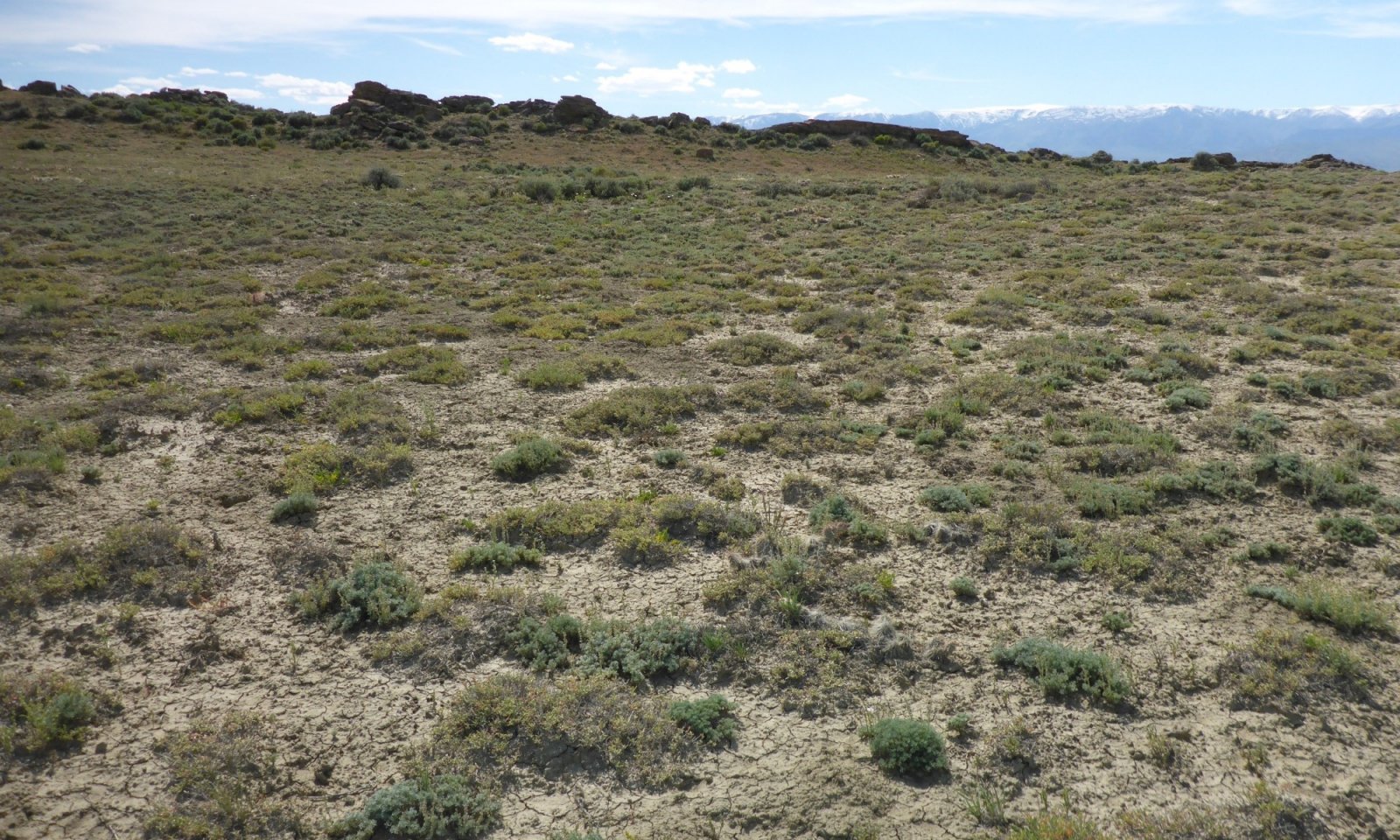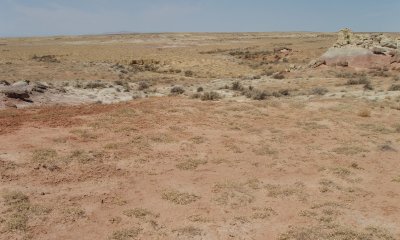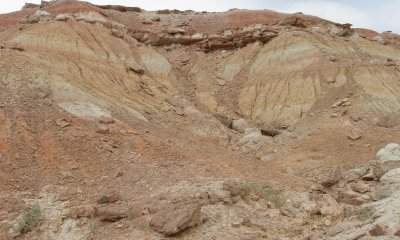
Shale (Sh) Big Horn Basin Core
Scenario model
Current ecosystem state
Select a state
Management practices/drivers
Select a transition or restoration pathway
-
Transition T1A
Natural Variability, Frequent and Severe Grazing, Severe Ground Disturbance, Drought or a combination of these factors eliminates/prevents perennial grass establishment and supports Gardner's saltbush.
More details -
Transition T1B
Frequent and Severe Grazing, Ground Disturbance, and/or Drought with a seed source present provides weedy species the opportunity to invade this community.
More details -
Restoration pathway R2A
Long-term Prescribed Grazing allows existing populations to gain vigor and encourages seedlings if seed source is available and climatic conditions are favorable. This site may require mechanical or cultural inputs to allow minor improvements in a foreseeable time frame.
More details -
Transition T2A
Drought, Frequent or Severe Grazing, Non-Use, or Ground Disturbance with seed source present exposes this barren community to invasion by weedy species.
More details -
Restoration pathway R3A
Integrated Pest Management with Grazing Lands Mechanical Treatment, or Rangeland Seeding with Prescribed Grazing will be required inputs to alter the soils and hydrology of this site to allow a desirable plant cover to establish and control the invasive species (species dependent.)
More details -
Transition T4A
Drought, Lack of Maintenance, or Further Ground Disturbance with seed source present exposes this disturbed community to (re-)invasion by weedy species.
More details -
No transition or restoration pathway between the selected states has been described
Target ecosystem state
Select a state
Description
Shale, much like the saline upland ecological sitse, is a dynamic and complex concept that includes a wide range of soil chemistry, that work together to create a salt-tolerant community. Field sampling cannot capture the full dynamic of the chemistry and the current lack of soil laboratory data prevents clear separation of specific characteristics. Composition and production for this State and State 2 have been designed to incorporate the range of possibilities.
Characteristics and indicators
Soils within the 5-9" precipitation zone, and with a wide range of alkali, saline, sodic and/or gypsum influences, are characterized by Gardner's saltbush dominated plant communities. These communities may also have bud sagebrush, birdfoot sagebrush, pursh seepweed, and in some locations greasewood; these woody species together will comprise approximately 60% of the production on the site.
The grass, comprising 30% of the plant community, is predominately bottlebrush squirreltail; however, Indian ricegrass, rhizomatous wheatgrasses, and alkali sacaton are common. Needleandthread and blue grama are incidental in this state. The forb component is minor with only 10% of the production from a few select forbs. A variety of biscuitroot/desert parsleys (Lomatiums), wild onion, and woodyaster are found in this state. As this site degrades, flatspine stickseed will increase
Resilience management
The site is naturally prone to erosion and drought, and so the species adapted to this site are hardy and resilient. However, this community is fragile, and is susceptible to rapid degradation with focused use. This site is generally not located in areas that are readily utilized by livestock or for general daily activity.
Submodel
Description
A saltbush dominant site with bare ground is the most prominent native community for the Shale ecological site. It is not listed as reference because there is potential for native grasses to be present on this site. Complexity of chemistry may be one factor for the lack of grasses and forbs in this state, but management can also contribute to the shift. The determination if this state is produced by soil texture, management, or climatic conditions may not be conclusive, and require additional investigation.
Characteristics and indicators
The indicator marking the shift to State 2, is the lack or loss of perennial grasses. The dominant structure of this site is Gardner's Saltbush, with a possible composition of birdfoot sagebrush and native forbs such as flatspine stickseed, purple tansyaster, prickly pear cactus and woodyaster.
Resilience management
It is recognized that with continued grazing pressure and drought conditions, the productivity and sustainability of most perennial grasses will decrease leaving a shrub dominated state. In the absence of invasive species, this state can persist on the landscape. Very long-term prescribed grazing and grazing land mechanical treatment (with seeding possibly) may be practices that can be used to bring this state near or similar to reference. Remnant populations of native perennial grasses will persist in pockets within the Gardner's Saltbush, but in some instances, seeding may be required to help re-establish herbaceous species to these sites. No research was located for large areas of re-vegetation, but limited success has occurred with seeding trials completed by BLM and University of Wyoming.
Submodel
Description
The Shale site has the presence of being resistant to invasion by many undesirable species threatening the rangelands today. However, there are a few species that still present issues as these lands are disturbed by development, continued drought, and shifts in use patterns. Many of these sites are at risk from local threats such as mustards, Russian thistle, and clasping pepperweed; as well as the national threats of halogeton, cheatgrass (downy brome), and a variety of thistles. The persistence, resistance and resilience of specific communities within this state will be discussed further below.
Characteristics and indicators
The Invaded/Gardner's Saltbush site will vary between a mirror image of State 1 or State 2 with an invasive species such as cheatgrass or halogeton present as a significant component of the community (>5% composition).
Resilience management
The persistence, resistance and resilience of specific communities within this state are dependent on the factor that introduced the invader species, and what invader species establishes on the site.
Submodel
Description
Mining/energy development and roads are the land uses that have had an impact on this site. Much of the land correlated as Shale is deemed unfit or non-productive, and either no attempt was made to reclaim areas or reseeding attempts have failed. As this land recovers, is restored or reclaimed, or further disturbances occur, the site potential and stability is greatly affected. Specific references will be discussed below.
Characteristics and indicators
Outside of obvious land movement scars and remnants of disturbance activities, the lack of all woody vegetation, presence of seeded (introduced/native) species, or the presence of Russian thistle, halogeton, and other primary succession or invasive species are the key indicators that a community is altered or disturbed. Many times, erosion control techniques, drill rows, or contouring is obvious for a significant time following the treatments.
Resilience management
Erosion control and weed control are the two factors that determine the ability for this site to maintain an improvement (range seeding). If left to recover naturally, or with no improvements, erosion will be the greatest concern affecting the resiliency of this ecological site.
Submodel
Transition T1A


Mechanism
Natural Variability, Frequent and Severe Grazing, Severe Ground Disturbance, and/or Drought - The combination of frequent and severe grazing and drought reduces the key bunchgrasses of this community. With no recovery time or rest, the herbaceous species may become very sparse and grasses specifically will be removed from the community leaving a saltbush dominated site. Extended long periods of drought alone, or severe ground disturbance, reduces or inhibits resiliency of this community, including Gardner's saltbush. Combinations of soil chemistry may also be a natural factor for the lack of grasses in the system to begin with. Soils that are high in both sodium and gypsum are commonly less accommodating to grasses.
Constraints to recovery
The soil chemistry, fine-textures, and depth to shale create a hostile environment for seedling establishment. The added tendency of forming soil crusts, become extremely hard or fluffy, and the lack of seed source make it very difficult for this community to recover under natural circumstances.
Transition T1B


Mechanism
Frequent and Severe Grazing, Ground Disturbance, and/or Drought with a seed source present - The combination of frequent and severe grazing and drought reduces the key bunchgrasses of this community and provides invasive species the opportunity to establish once the seed source is present. Hoof impact, an intensive storm event, or other single disturbance can be enough to create the niche needed for invasive species seedling establishment.
Constraints to recovery
Ease of access, constraints of herbicides due to slope and soil chemistry, and the specific species of invasion are the major limitations to recovery for this site. The lack of native/desirable seed source and the hostile germination environment of these very shallow, heavy textured, salt-laden soils are also major players in the potential of this community.
Restoration pathway R2A


Mechanism
Prescribed Grazing (Long-term), (possibly with seeding) – By reducing use and allowing native grasses to recover with prescribed grazing, the potential to recover is dependent on a seed source and climate. However, the time required may not be feasible. The natural availability of native seed is minor in this environment, and the seedling viability/establishment is limited due to soil properties.
Native seed mixtures that have been proven to tolerate saline, sodic, or saline/sodic soils are not necessarily the key species for the Reference communities. Once a site is seeded (drilled or broadcast seeding), the response to management and climatic conditions may be altered, and the site will not function as a native (undisturbed) site, and would correlate as a altered/disturbed state.
Context dependence
Previous mention of the natural variability in the chemistry of this ecological site lends to a natural occurrence of the Garner's saltbush / Bare Ground state. In the context of recovery, when the community is naturally occurring due to the limitations of the chemistry in the soil, the only option for improving the site would be to mechanically seed and amend the soil. This has been attempted with varying degrees of success. But once it has been mechanically altered, the site would revert to State 4 - Altered/ Disturbed Lands.
Relevant conservation practices
| Practice | External resources |
|---|---|
|
Critical Area Planting |
|
|
Mulching |
|
|
Prescribed Grazing |
|
|
Grazing Land Mechanical Treatment |
|
|
Range Planting |
|
|
Heavy Use Area Protection |
|
|
Integrated Pest Management (IPM) |
|
|
Upland Wildlife Habitat Management |
|
|
Early Successional Habitat Development/Management |
|
|
Planned Grazing System |
|
|
Native Plant Community Restoration and Management |
|
|
Prescribed Grazing |
|
|
Invasive Plant Species Control |
|
|
Intensive Management of Rotational Grazing |
|
|
Prescriptive grazing management system for grazed lands |
Mechanism
Non-Use, Ground Disturbance (with seed source present), Drought, Frequent or Severe Grazing – Once a community has transitioned to a saltbush dominated community, productivity and functionality of the site are at risk. If further disturbance (livestock, human or environmental disturbance) occurs, or a seed source is introduced into this at-risk community, annuals and other less desirable species gain the opportunity to establish.
Constraints to recovery
The ease of access due to slope and lack of desirable roads, as well as soil inhibitions with herbicides can make treating or controlling weeds difficult. The need to stabilize the soils (reduce erosion) along with weed control can make the economics of treating this community challenging.
Context dependence
The specific species of invasive weeds that are established on a location, the size of the community that is being treated, and the specific soil chemistry will all alter how a location will respond to the invasion and/or the treatment.
Mechanism
Integrated Pest Management, Grazing Land Mechanical Treatment, or Rangeland Seeding with Prescribed Grazing – Once invasive species such as cheatgrass, halogeton, or thistles are established, complete eradication is generally not a feasible option, limiting the ability to restore the community to a higher state. An invaded site, however, can be restored to a functional plant community through intensive or integrated pest management. Grazing land mechanical treatments to reduce existing invasive populations and to introduce forage species that are desirable, adapted to the soils, and able to compete with the invasive species will possibly improve the grazing suitability of this community. Establishment will be slow and the variety of available seed sources for saline/sodic/alkaline/gypsic soil conditions is limited; however, small scale projects have been achieved with marginal success.
Context dependence
The location-specific soil properties, the available seed sources, the invader species involved, and the accessibility of the site are all factors that will determine the best approach for this community.
Relevant conservation practices
| Practice | External resources |
|---|---|
|
Critical Area Planting |
|
|
Mulching |
|
|
Prescribed Grazing |
|
|
Grazing Land Mechanical Treatment |
|
|
Range Planting |
|
|
Heavy Use Area Protection |
|
|
Integrated Pest Management (IPM) |
|
|
Upland Wildlife Habitat Management |
|
|
Early Successional Habitat Development/Management |
|
|
Planned Grazing System |
|
|
Native Plant Community Restoration and Management |
|
|
Prescribed Grazing |
|
|
Invasive Plant Species Control |
|
|
Grazing Management Plan |
|
|
Grazing management to improve wildlife habitat |
|
|
Prescriptive grazing management system for grazed lands |
Mechanism
Non-Use, Disturbance, Severe and Frequent Grazing, Drought with a seed source present – Loose soils as a result of non-use and/or chemistry within the soil provides a seedbed for introduced seeds to germinate. The decrease in key species due to severe and frequent grazing, drought or disturbance opens the canopy and provides opportunity for invasive species to establish. Continued pressure, added disturbances, or introduction of undesirable species will weaken and trigger a shift from the altered / disturbed state to an Invaded state.
Constraints to recovery
The very shallow, fine-textured, salt-laden nature of these soils inhibit or creates a hostile environment for seedling establishment. Access can make weed treatment/prevention difficult, as well as chemical binding issues with soil chemistry can be a concern.
Model keys
Briefcase
Add ecological sites and Major Land Resource Areas to your briefcase by clicking on the briefcase (![]() ) icon wherever it occurs. Drag and drop items to reorder. Cookies are used to store briefcase items between browsing sessions. Because of this, the number of items that can be added to your briefcase is limited, and briefcase items added on one device and browser cannot be accessed from another device or browser. Users who do not wish to place cookies on their devices should not use the briefcase tool. Briefcase cookies serve no other purpose than described here and are deleted whenever browsing history is cleared.
) icon wherever it occurs. Drag and drop items to reorder. Cookies are used to store briefcase items between browsing sessions. Because of this, the number of items that can be added to your briefcase is limited, and briefcase items added on one device and browser cannot be accessed from another device or browser. Users who do not wish to place cookies on their devices should not use the briefcase tool. Briefcase cookies serve no other purpose than described here and are deleted whenever browsing history is cleared.
Ecological sites
Major Land Resource Areas
The Ecosystem Dynamics Interpretive Tool is an information system framework developed by the USDA-ARS Jornada Experimental Range, USDA Natural Resources Conservation Service, and New Mexico State University.

